Overview
The primary inquiry explored in this article is whether project managers ought to rent or purchase a skill saw, taking into account several critical factors. This decision is significantly influenced by:
- Cost analysis
- Frequency of use
- Project duration
Renting typically presents lower initial costs and greater flexibility for short-term projects; however, purchasing can prove to be more economical and practical for those who require frequent use and have long-term needs, due to the potential for savings and the advantages of ownership.
Key Highlights:
- Cost analysis is crucial; while renting has lower upfront costs, cumulative rental fees can exceed purchase costs for frequent users.
- Frequency of use influences the decision; regular tasks may justify purchasing, while occasional tasks favour renting.
- Project duration matters; renting is ideal for short-term projects, while long-term projects may warrant purchasing.
- Ownership entails maintenance and storage responsibilities, adding complexity, while renting alleviates these concerns.
- Renting provides access to high-quality equipment without ownership obligations, beneficial for specialised tasks.
- Renting offers lower initial costs, access to the latest models, and no maintenance responsibilities.
- Flexibility in renting allows for adjusting equipment needs based on project requirements.
- Renting can lead to long-term expenses exceeding ownership costs for regular use.
- Limited availability during peak seasons can delay access to rental equipment.
- Ownership allows for quality control, instant accessibility, customization, and potential resale value.
- Purchasing involves high initial investment, maintenance responsibilities, storage requirements, depreciation, and risk of obsolescence.
- To decide, assess requirements, calculate costs, consider future needs, evaluate quality, and make an informed choice.
Introduction
When confronted with the decision to rent or purchase a skill saw, project managers navigate a complex landscape of considerations that can significantly influence their project's success. This choice is not solely about immediate costs; it encompasses long-term implications, frequency of use, and maintenance responsibilities. As project leaders tackle this critical decision, they must consider pivotal questions:
- Is the flexibility of rental worth the potential long-term savings of ownership?
By understanding the key factors at play, managers can empower themselves to make informed choices that align with their project needs and financial constraints.
Evaluate Key Factors in Skill Saw Rental vs. Purchase
When project managers confront the choice of skill saw rental or purchasing, several critical factors demand careful evaluation.
- Cost Analysis: A comprehensive examination of the total cost of ownership versus rental fees is imperative. While renting usually incurs lower upfront costs, the cumulative expenses over time can render purchasing more economical for frequent users. For instance, skill saw rental costs in the Dallas-Fort Worth region typically range from $30 to $50 daily, which can accumulate significantly for extended projects.
- Frequency of Use: The frequency with which the skill saw will be employed plays a crucial role in the decision-making process. For tasks requiring regular use, purchasing may yield superior financial returns. Conversely, for occasional tasks, a skill saw rental often proves to be the more practical choice.
- Project Duration: The length of the project is another determining factor. Renting is generally more advantageous for short-term projects, offering flexibility without the burdens of ownership. In contrast, long-term projects may justify the investment in purchasing, especially when considering the potential for future use.
- Maintenance and Storage Considerations: Ownership brings ongoing maintenance and storage responsibilities, complicating logistics and potentially increasing overall costs. Renting, such as through a skill saw rental, alleviates these concerns, as the rental company typically manages upkeep, ensuring that equipment is in optimal condition without additional effort from the manager.
- Quality and Availability: Renting provides access to high-quality, well-maintained equipment without the obligations of ownership. This is particularly beneficial for specialized tasks that may require specific features or capabilities not found in lower-end models. Project leaders often appreciate the ability to choose from a variety of equipment tailored to their current needs, ensuring they have the right tool for the job.
In practical scenarios, supervisors frequently weigh these elements. For example, a supervisor managing a short-term renovation might opt for a skill saw rental to minimize expenses and avoid maintenance responsibilities, while another overseeing a long-term construction project may choose to purchase to ensure consistent access to the tool. Ultimately, the decision hinges on a thorough assessment of these key factors, aligning with the project's specific requirements and budget constraints.
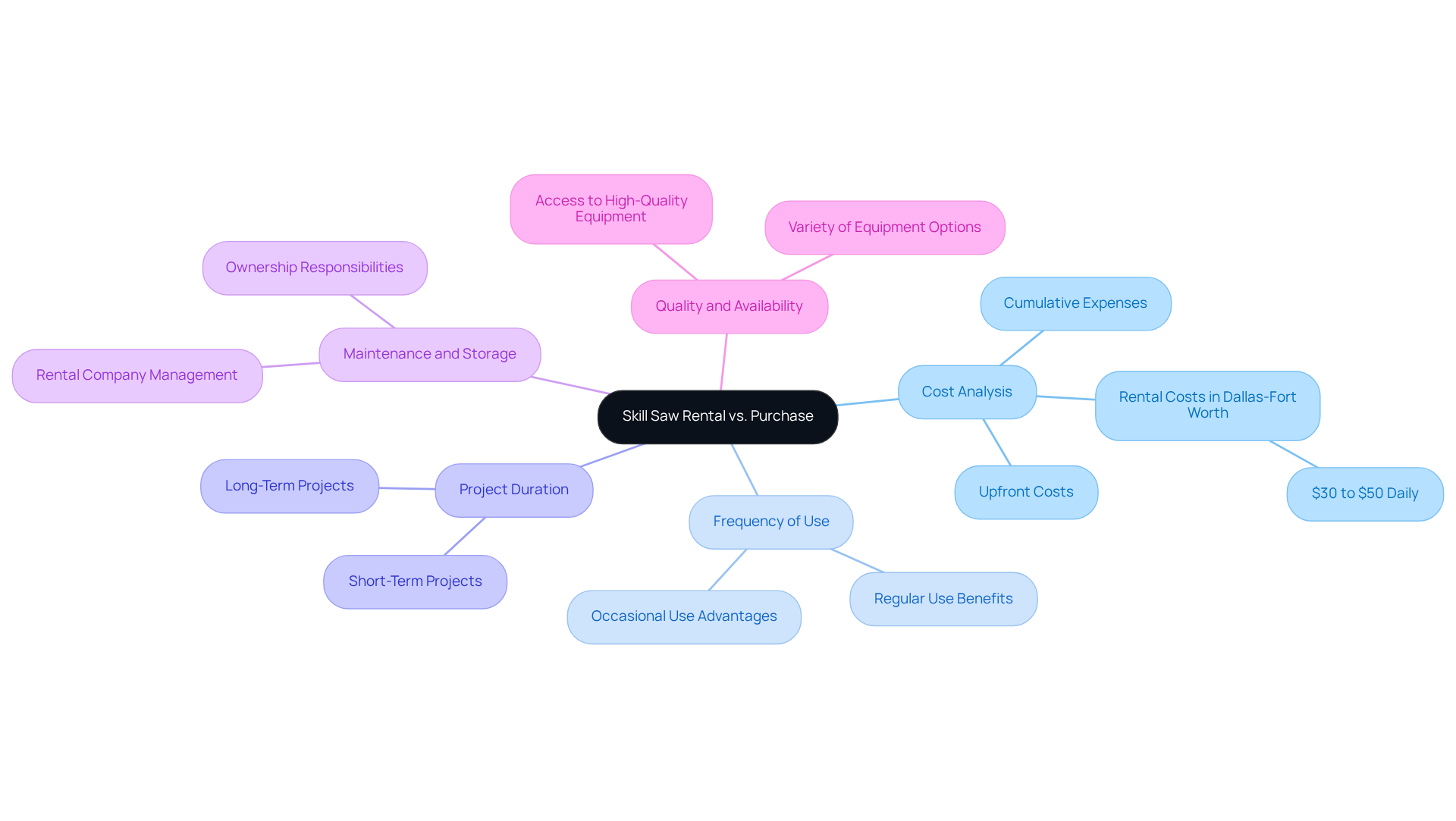
Explore Advantages of Renting a Skill Saw
A skill saw rental offers a multitude of advantages for project managers, establishing it as a strategic choice for construction projects.
- Lower Initial Costs: Renting typically demands a lower upfront investment compared to purchasing, allowing supervisors to allocate resources to other critical aspects of their projects. For example, while renting a mini excavator may cost around $300 per day or $900 per week, the purchase price can exceed $40,000. This financial flexibility is essential for effective project management.
- Access to the Latest Models: Rental companies, such as EZ Equipment Rental, located at 1307 W Airport Fwy, Irving, TX, provide access to the latest tools and technology, including skill saws, boom lifts, and excavators. This ensures that supervisors can utilize the most efficient and advanced tools available, meeting the growing demand for cutting-edge construction machinery, as noted by industry experts.
- No Maintenance Responsibilities: When renting, EZ Equipment Rental takes care of maintenance and repairs, alleviating the pressure on coordinators and enabling them to concentrate on task execution. This arrangement eliminates unexpected repair costs and service demands that could disrupt budgets and timelines.
- Flexibility: Renting equips supervisors with the ability to adjust equipment needs based on project requirements, allowing for scaling resources up or down as necessary. This adaptability is increasingly valued by construction professionals in today’s ever-changing market.
- Try Before You Buy: A skill saw rental affords the opportunity to evaluate the tool before making a purchase commitment, enabling leaders to assess its suitability for specific tasks and confirm it meets their operational needs.
These advantages resonate with current trends in the equipment rental market, where flexibility and access to advanced technology are paramount for construction professionals. As the industry progresses, managers are recognizing that renting not only enhances efficiency but also supports improved budget management and outcomes.
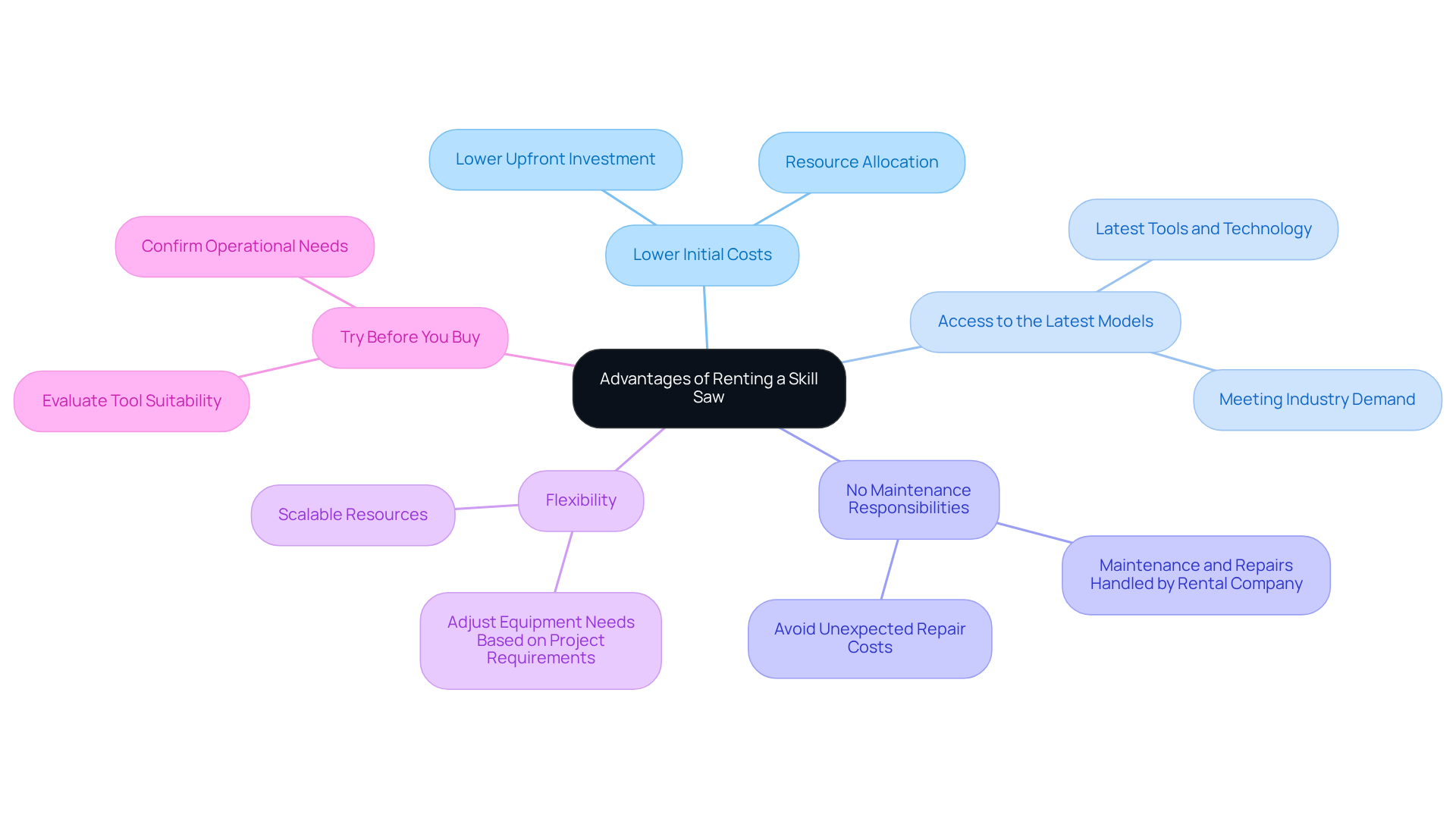
Assess Disadvantages of Renting a Skill Saw
While a skill saw rental provides flexibility, several disadvantages warrant careful consideration.
- Increased Long-Term Expenses: For ventures necessitating regular utilization, the combined rental charges can exceed the expense of acquiring the equipment outright. This is particularly true when accounting for concealed costs linked to leases. Such additional expenses can significantly impact the overall budget, ultimately making ownership a more economical choice in the long run.
- Limited Availability: During peak construction seasons, the demand for skill saw rental equipment often spikes, resulting in potential delays in securing the necessary tools. Statistics indicate that these delays related to rental equipment availability can lead to costly setbacks, underscoring the significance of planning in advance.
- No Equity: Utilizing a skill saw rental means managers do not build equity in the equipment. This absence of ownership can be a drawback for individuals requiring the resource for various tasks, as it hinders long-term investment in vital assets. Possessing equipment can offer strategic benefits, including the capacity to tailor and maintain it based on specific requirements.
- Potential Quality Variability: Quality can significantly fluctuate in the state of skill saw rental equipment. Managers may encounter difficulties with inadequately maintained equipment, jeopardizing quality and safety. Furthermore, while maintenance responsibilities often fall on the lessor, the variability in care for skill saw rental can lead to unexpected issues.
- Logistical Challenges: Coordinating the pickup and return of skill saw rental equipment adds complexity to management. This is especially true when multiple tools are needed, potentially interrupting workflow and prolonging timelines. Additionally, there could be fines for damage or deterioration on leased equipment, introducing another layer of logistical consideration for those overseeing projects.
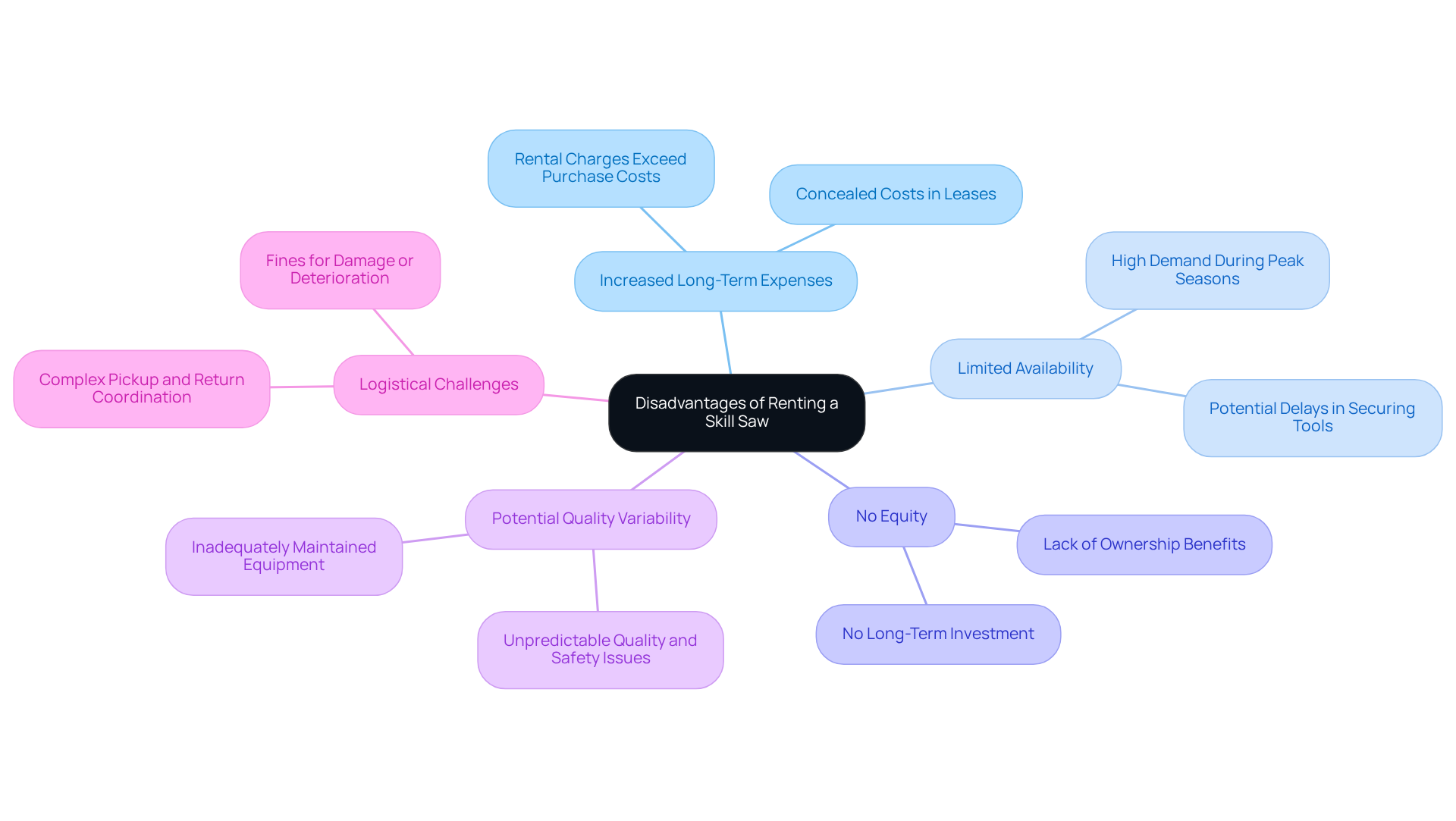
Identify Benefits of Purchasing a Skill Saw
Investing in a skill saw rental provides project managers with significant advantages that can enhance their operations.
- Long-Term Cost Savings: Owning a skill saw can lead to substantial savings over time, especially for those who require frequent use. By eliminating ongoing rental costs, supervisors can allocate resources more efficiently. According to the EquipmentWatch report, some supervisors report savings of 30-50% when opting for ownership instead of skill saw rental options.
- Control Over Quality: Ownership empowers supervisors to select superior equipment that aligns with their specific standards and requirements. This control over quality fosters better outcomes and increased satisfaction. As Jason Dudas, a CPA and construction expert, observes, having reliable equipment readily available not only boosts productivity but also instills a sense of readiness, ultimately culminating in more successful results.
- Instant Accessibility: Having a skill saw on hand ensures that supervisors can utilize the tool whenever necessary, minimizing downtime and enhancing overall task efficiency.
- Customization: Owners enjoy the flexibility to modify or upgrade their skill saws to meet particular task demands, ensuring that the equipment is always tailored for the job at hand.
- Potential Resale Value: Should the need for the skill saw diminish, it can be resold, allowing supervisors to recoup a portion of their initial investment. Auction sales data reveals that nearly half of all companies prefer auctions as a means of selling their equipment, highlighting an effective strategy for recovering investments.
Statistics indicate that owned equipment often results in lower long-term expenses compared to skill saw rental, with some managers noting savings of 30-50% through ownership. Industry specialists emphasize that having dependable resources readily available not only enhances productivity but also fosters a sense of preparedness, ultimately leading to more successful outcomes.
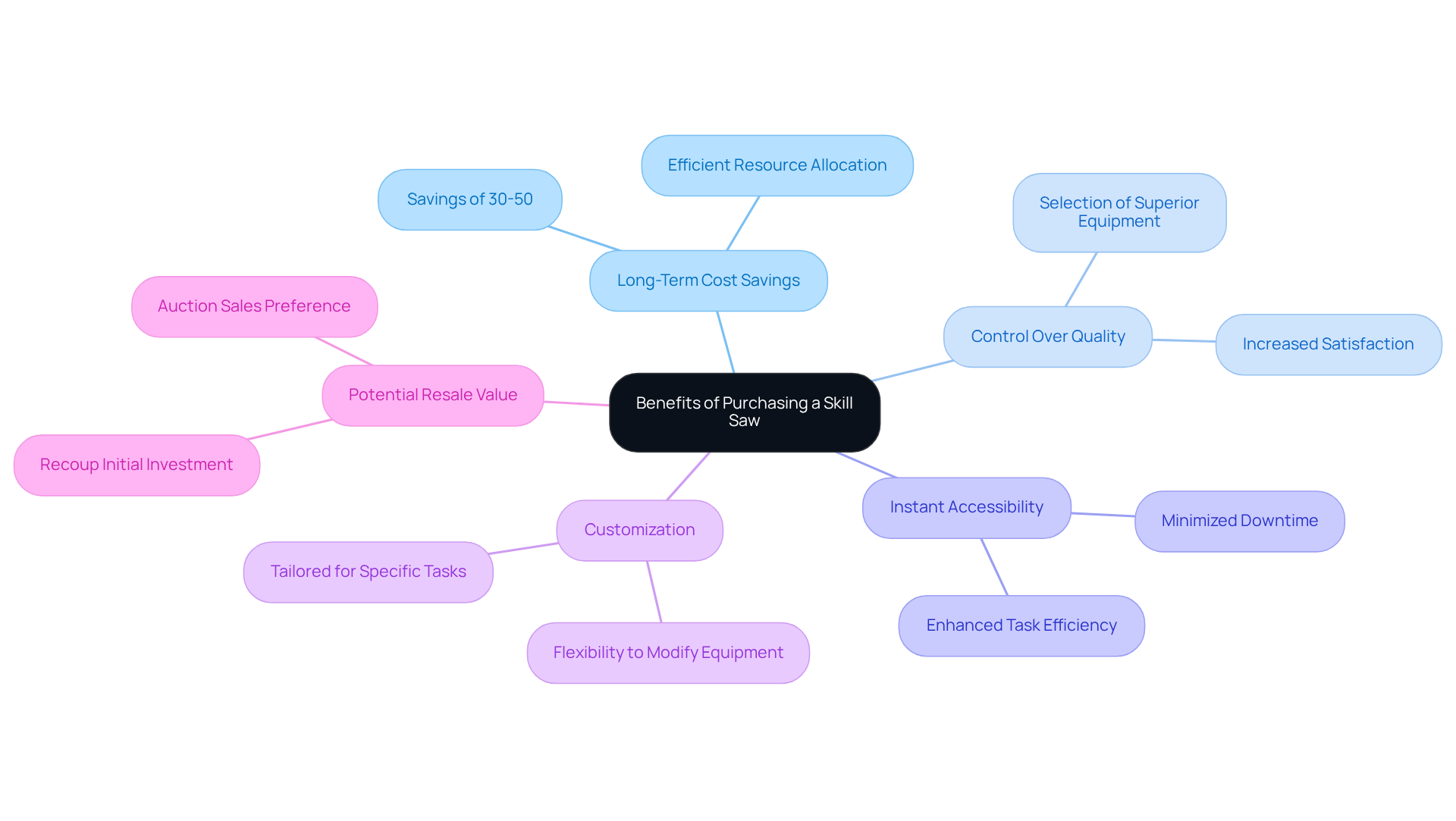
Consider Drawbacks of Purchasing a Skill Saw
While purchasing a skill saw offers various advantages, it is essential to consider the potential drawbacks that accompany such an investment.
- High Initial Investment: The upfront cost of acquiring a skill saw can be substantial, potentially straining budgets, especially for smaller projects. This initial financial commitment requires careful consideration.
- Maintenance Responsibilities: Ownership comes with the responsibility of upkeep and repairs, which can add to overall costs and demand both time and resources. It is crucial to factor in these ongoing obligations when evaluating the purchase.
- Storage Requirements: A skill saw necessitates adequate storage space, posing challenges for supervisors with limited facilities. Ensuring a suitable storage solution is vital for maintaining the tool's condition.
- Depreciation: Over time, tools can lose value, and should a supervisor decide to sell the saw later, recovering the full investment may not be feasible. This aspect highlights the importance of assessing long-term value.
- Risk of Obsolescence: With technological advancements, purchased tools can become outdated, prompting the need for further investment in newer models. Staying informed about industry trends can mitigate this risk.
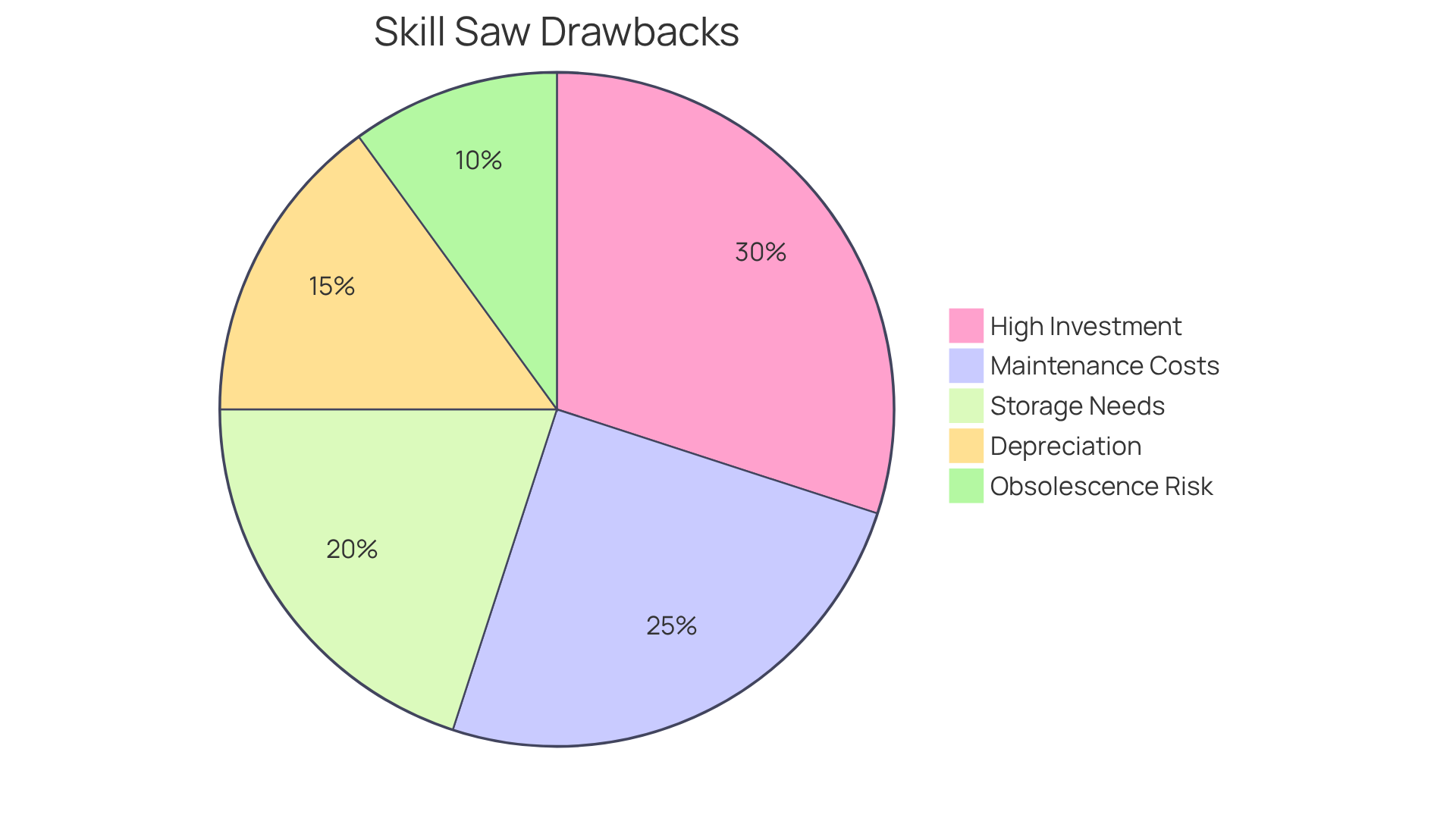
Make an Informed Decision: Rental vs. Purchase
To make an informed decision between renting and purchasing a skill saw, project managers must follow these essential steps:
- Assess Requirements: Begin by evaluating the specific needs of the endeavor, such as the duration of use, frequency of need, and budget constraints. Understanding these factors is crucial for determining the most cost-effective option.
- Calculate Costs: Conduct a thorough comparison of the total costs associated with renting versus purchasing. This should include not only the rental fees but also potential maintenance, storage, and insurance costs that come with ownership. Notably, a skill saw rental can often be more economical for short-term needs, as the daily rental rates for a skill saw can exceed weekly rates after just three days. For example, a two-week rental can equal the cost of a monthly rental, making it essential to analyze the duration of use carefully.
- Consider Future Endeavors: Anticipate upcoming tasks and assess whether the skill saw will be necessary in the long term. If the device is expected to be utilized often across various tasks (more than 65% of the time), a skill saw rental may offer greater value over time.
- Evaluate Quality and Availability: Investigate the quality of rental options available. While skill saw rental provides access to the latest technology without the need for long-term commitment, owning a high-quality tool can enhance reliability and performance on the job site. Additionally, consider the tax implications of purchasing, such as the IRS Section 179 Deduction, which allows for deductions on new and used capital equipment.
- Make a Choice: After examining all elements, select the option that best aligns with objectives, budget limitations, and operational requirements. A systematic method for assessing these options can result in substantial savings and enhanced efficiency. Including insights from project managers who have navigated similar decisions can also provide valuable perspectives.
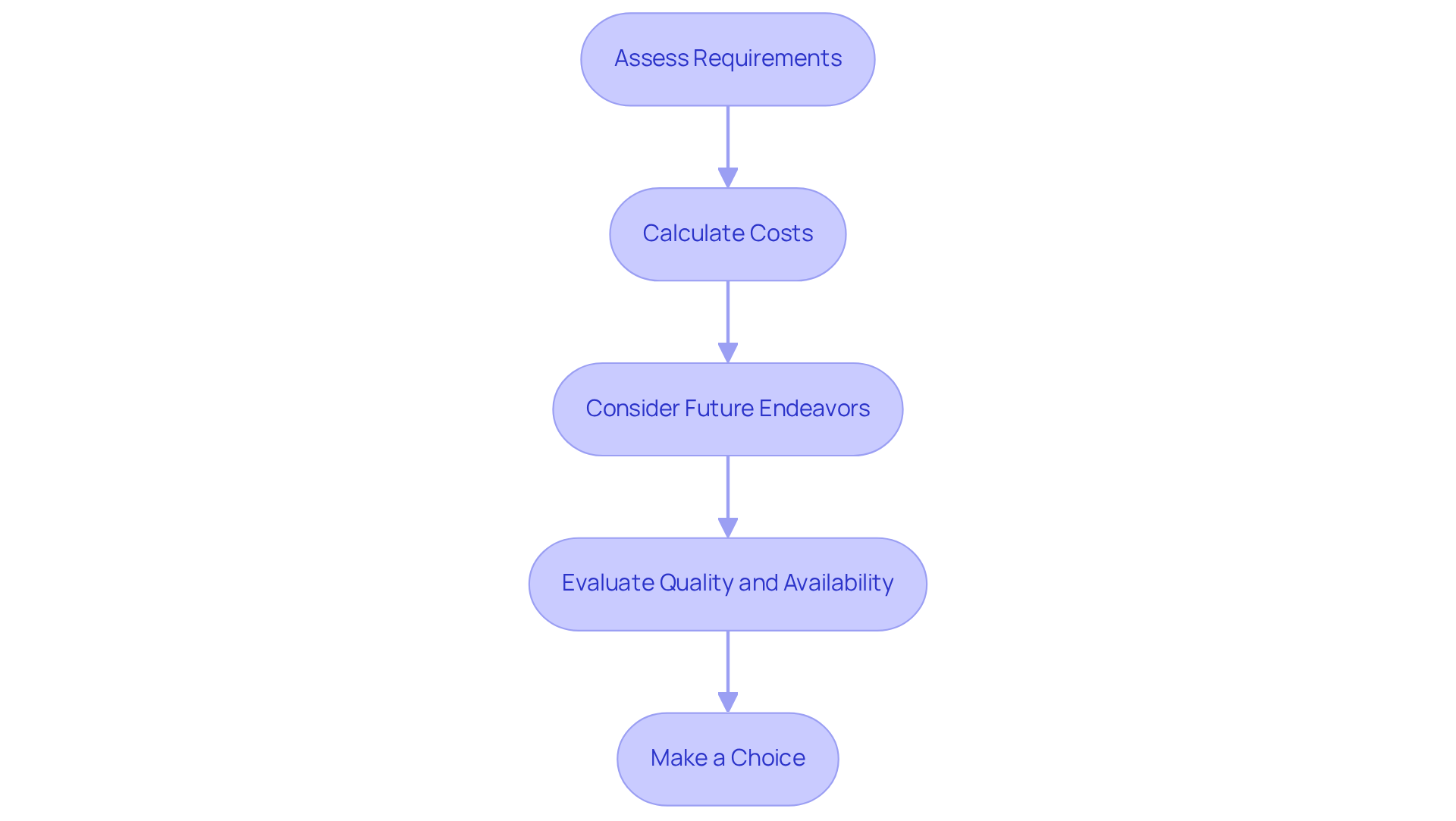
Conclusion
Evaluating whether to rent or purchase a skill saw is a pivotal decision for project managers, influenced by several key factors. The choice ultimately hinges on a careful analysis of:
- Costs
- Frequency of use
- Project duration
- Maintenance responsibilities
- Quality of equipment needed
Each of these elements plays a significant role in determining the most effective and economical approach for specific project requirements.
Throughout the discussion, it becomes clear that renting offers advantages such as lower initial costs, access to the latest models, and reduced maintenance responsibilities, making it an appealing option for short-term projects. Conversely, purchasing a skill saw can lead to long-term savings and greater control over quality, particularly for managers who require frequent access to the tool. However, the drawbacks of both options, including potential long-term expenses and the responsibilities of ownership, must also be considered to make an informed decision.
In conclusion, the decision between skill saw rental and purchase is not merely a financial one but involves strategic planning and foresight. Project managers are encouraged to thoroughly assess their specific needs, calculate costs, and consider future requirements before making a choice. By taking a systematic approach, managers can optimize their resources and ensure they select the best option for their projects, ultimately leading to improved efficiency and project success.
Frequently Asked Questions
What factors should be evaluated when deciding between skill saw rental and purchase?
Key factors include cost analysis, frequency of use, project duration, maintenance and storage considerations, and quality and availability of equipment.
How does cost analysis influence the decision to rent or purchase a skill saw?
A comprehensive cost analysis compares the total cost of ownership against rental fees. While renting has lower upfront costs, cumulative rental expenses over time may make purchasing more economical for frequent users.
How does the frequency of use affect the decision to rent or buy a skill saw?
For tasks requiring regular use, purchasing a skill saw may provide better financial returns. In contrast, for occasional tasks, renting is often the more practical option.
What role does project duration play in the rental versus purchase decision?
Renting is generally more advantageous for short-term projects due to flexibility, while long-term projects may justify purchasing for consistent access to the tool.
What are the maintenance and storage considerations when owning a skill saw?
Owning a skill saw involves ongoing maintenance and storage responsibilities, which can complicate logistics and increase overall costs. Renting alleviates these concerns as the rental company manages upkeep.
What are the quality and availability benefits of renting a skill saw?
Renting provides access to high-quality, well-maintained equipment without ownership obligations, allowing project leaders to choose from various tools tailored to their needs.
What are the advantages of renting a skill saw?
Advantages include lower initial costs, access to the latest models, no maintenance responsibilities, flexibility in adjusting equipment needs, and the opportunity to try before buying.
How does renting a skill saw contribute to project management?
Renting allows supervisors to allocate resources more effectively, utilize advanced tools, and focus on task execution without the burden of maintenance and repair responsibilities.




